OF THE
STANDARD
GENERAL APPEARANCE
:
The British Breed Standard does not give specific guidelines to size and
weight; it simply requests a "large, massive, powerful, symmetrical,
well-knit frame." We are therefore looking for a very large, very
powerful, and very massive dog, but the massiveness and height must come
from the depth of the body rather than the legs, in the approximate proportion
of two-thirds body to one-third legs. A Mastiff should not be too tall
and gangly. The American Breed Standard asks for dogs to have a minimum
height of 30 inches at the shoulder, and bitches should be 27.5 inches.
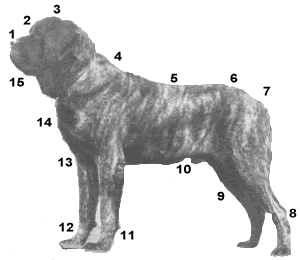 |
1: Muzzle |
TEMPERAMENT:
The Mastiff has a very loyal temperament; this is simply described
in the British Standard as "Calm, affectionate to owners, but capable
of guarding." There is a little more detail in the American Standard,
and words such as 'dignity' and 'courage' build up a good picture.
Several countries are introducing 'Temperament Tests' as part of the qualification
towards gaining the title of Champion, and this is normally included in
the Club Championship Show. This can lead to problems if a dog is rewarded
for showing aggression, as can be the case. While it may be right to penalise
a dog which is a quivering heap in the ring, no matter how good it may
otherwise be, we do not want to go to the opposite extreme and encourage
a dog to attack as proof of its 'guarding' abilities. The American Standard
specifically states that "Judges should not condone shyness or viciousness"
HEAD:
The Mastiff is an extremely 'head conscious' breed, and the description
of the head forms the largest part of both the British and American Standard.
It is, however, quite difficult to visualise if one is not familiar with
the breed.
It is the head which really makes the Mastiff; it must be big, broad and
flat across the skull, with ears set at the highest point so that the
line across the ears and the skull is continuous. The stop between the
eyes must be pronounced, not shallow, and the muzzle itself must be very
broad and deep - these two proportions should be almost the same. So many
Mastiffs have muzzles which narrow and appear to taper, or which are not
filled out under the eyes, giving a weak appearance. It should, as the
British Standard says, be blunt, cut off squarely. The length of the muzzle
to the head should be as 1 to 3.
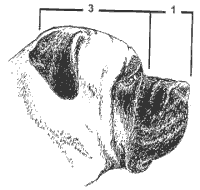 Correct head proportions, seen in profile. |
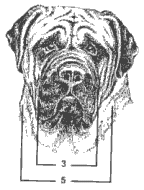 Correct head proportions from the front. |
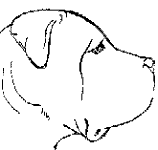 Plain head, lacking stop. (Defect) |
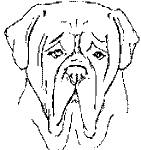 Narrow muzzle, lacking underjaw. (Defect) |
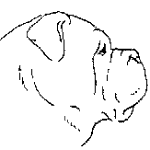 Muzzle too short. (Defect) |
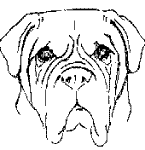 Round prominent eyes showing haw. (Defect) |
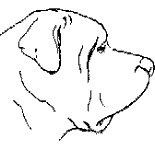 Long snipey muzzle. (Defect) |
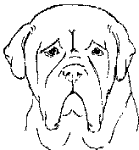 Domed skull, low-set ears. (Defect) |
One very important point here is the question of wrinkle, and this differs between the British and the American Standards. The British Standard asks for the forehead to be flat but wrinkled when alert, whereas the American Standard calls for "marked wrinkles which are particularly distinctive when at attention". This one small phrase does make quite a difference to the appearance of the heads. As far as the British Standard is concerned, this should mean that the head should be comparatively 'dry', with the wrinkle making all the difference to the dog's appearance and expression when the ears are raised and the dog is interested or excited. In British show rings this is being wrongly interpreted, and too many Mastiffs are showing a continually wrinkled head, combined with excessive folds of flesh down the sides of the cheek, making the Mastiff look rather lioke a Bloodhound. The difference between the correct amount of wrinkle and too much wrinkle can make all the difference to the overall picture.
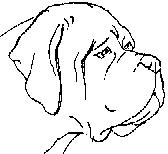 Long houndy ears. |
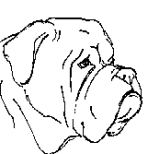 Excessively undershot |
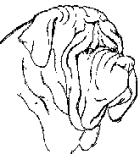 Over-wrinkled |
To summarise, the
two main faults that are seen in the show ring are narrow, weak muzzles
and over-wrinkling. Of the two, the snipey, weak muzzle, lacking strength
under the eyes, should be more severely penalised. However, the appearance
of the head, in its finer points, has been interpreted in many different
ways by many different people. All one can say in conclusion is that breeders,
judges and exhibitors must be governed by the requirements of their national
Breed Standard, which stipulates the correct and desired type of head.
The Breed Standard is the blueprint and it should be followed in all its
details.
EYES:
Eyes should be small, set wide apart and dark in colour. There must not
be red haw showing. The ears should be small and thin to the touch, again
heavy ears are a common fault.
MOUTH:
Again we have a variation between the British and American Standards.
The American Standard states that a 'scissors bite is preferred' although
a moderately undershot jaw should not be faulted. The British standard
states that the lower jaw may project beyond the upper, " but never
so much as to show when the mouth is closed." This means that the
Mastiff is, quite legally, allowed to be slightly undershot, but so many
judges and even breeders do not appear to realise this. However, it should
be obvious that the very short, blunt, broad muzzle- which is absolutely
essential - is very difficult to combine with a scissor bite.
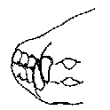 Level bite: desiderable |
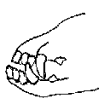 Slightly undershot: allowable |
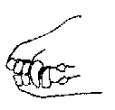 Overshot: incorrect |
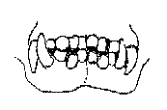 Teeth out of alignment: incorrect |
BODY:
The body slightly longer than high, not square like a Bullmastiff (this
is a very common fault). The chest must be broad and deep - as the saying
goes, "you don't want two legs coming out of the same hole."
When seen from the front, the chest must indeed be very broad, and should
come down at least level with the elbows. This will not be apparent in
young dogs, but when a Mastiff is fully mature the chest must be well
let down between the front legs so as to be level with the elbows. The
topline must be flat, and very wide in a bitch. It should be slightly
arched in the dog.
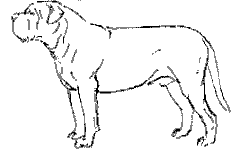 Long body, level topline: correct |
 Short body giving square appearance Tail set too low: defect |
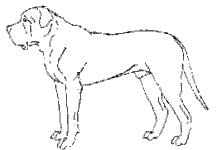 Lack of depth; too Dane-like: defect |
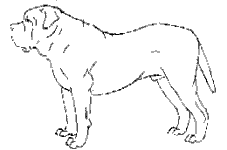 Dipping topline, tail too short: defect |
FOREQUARTERS:
The shoulders should be well-laid; they should not be upright - this is
a bad fault. Upright shoulders may make for greater height, but the front
action will suffer. Remember that the pasterns - the shoch absorbers -
will find it more difficult to absorb jarring from movement with upright
shoulders, as the jolting leads straight down the shoulders into the front
legs. In the Breed Standard the pasterns are required to be "upright",
but even so, there should be a degree of flexibility. Correct pasterns
and correctly placed shoulders give the essential cushioning to the heavy
body on the move.
 Correct front (correct) |
 Narrow front, feet turned out (defect) |
 Out at elbow, feet turned (defect) |
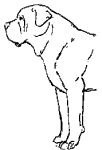 Correct upper arm and shoulder (correct) |
 Straight upper arm and short neck (defect) |
HINDQUARTERS:
The hindquarters must be strong, with a good bend of stifle. The American
Standard asks for the stifle joint to be moderately angulated, matching
the front. The British Standard does not mention this angulation at all.
It calls for hindquarters to be broad, wide and muscular, and the second
thigh must be well developed. It seems obvious from this that angulation
must be good, and not straight up-and-down like a Chow. However, these
straight and narrow hind legs are a common fault in the breed. Viewed
from the side, the back end should resemble that of a shirehorse rather
than a racehorse.
 Hindquarters squarely set: correct |
 Cow hocks (difetto) |
 Correct angulation |
 Straight stifles (defect) |
FEET:
The feet should be round and cat-like; they should not be spread out or
hare-like. These feet bear a tremendous amount of weight and must be up
to the work entailed. The nsails should be dark in colour and kept short.
In show stock the dew claws are often removed when the puppy is a day
or two old, but if these are not removed they must be watched to make
sure thay do not grow and curl round, sometimes back into the leg.
 Correct round foot |
 hare foot (defect) |
 splay foot Arched toes (defect) |
TAIL:
The tail is set on high, and should be carried straight, but with a little
curve upwards on the move or when excited. A low-set tail means that the
hindquarters eem to slope away downwards, instead of being level and straight
into the tail-set.The croup or rump must be strong and straight, and should
not fall or slope away. Some years ago it was common to find a 'cranked'
tail in one or two puppies in a litter - a throwback to the Bulldog -
but these now are very rarely seen.
COAT ANDCOLOUR:
The coat shoud be short and close-lying, but is allowed to be heavier
and thicker over the shoulders, neck and back. There is a great deal of
variation in coat lengths from the really long-coated (due to the St Bernard
ancestry, probably) to the Doberman type coat. However, the 'moderately
short' coat is correct. Although officially there are only three colours
of the breed - fawn, brindle and apricot - there can be quite an amount
of variation in the fawn and brindle colours. The fawn can vary from very
light, which used to be called silver-fawn, to much darker, bordering
on the red of the apricot or a donkey-brown. Brindles also vary from being
very nearly black in colour all over, with just a very few faint stripes,
to an apricot brindle where the stripes are a very attractive apricot
colour. However, a 'reverse brindle'. Where you have a light background
(instead of a dark background) with a very few faint stripes of another
colour is not desirable.
GAIT:
The British Standard confiines itself to "Powerful, easy extension",
whereas the American description of movement is far more detailed. A Mastiff
should move powefully and fgìreely, but it should not be expected
to move like a racehorse, or Great Dane. It should move not with grace,
but with strength. The movement of a Mastiff can be likened to the earth-shattering
movement of a Shire Horse. You cannot expect a dog of this build to move
in any other way.